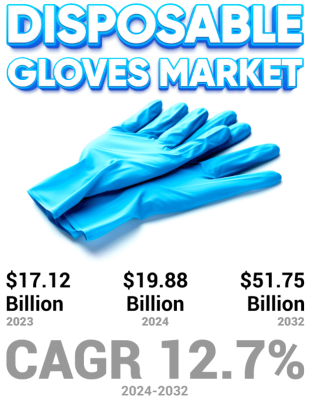Introduction
Definition
Disposable gloves play a crucial role in health and safety protection across various sectors, including healthcare, industry, and food services. They are designed for single use to prevent contamination and protect users from harmful agents. The disposable gloves market has experienced significant growth in recent years, especially due to the COVID-19 pandemic.
Market Segmentation
The disposable gloves market can be segmented based on material, application, and geographical region:
- By material: Includes nitrile, latex, vinyl, and polyethylene gloves.
- By application: Covers the medical, industrial, food service, and other sectors.
- By geography: The market is divided into North America, Europe, Asia-Pacific, Southeast Asia, and other regions.
Market Dynamics of Disposable Gloves
The disposable gloves market is influenced by various factors, including medical demand, consumer trends, technological advancements, and environmental policies.
Drivers
High demand in healthcare: The healthcare sector is the largest consumer of disposable gloves due to infection control requirements in hospitals, clinics, and laboratories. Hygiene standards have been further reinforced after the COVID-19 pandemic.
Growing awareness of hygiene and occupational safety: Industries such as food processing, beauty, manufacturing, and chemicals require gloves to protect workers and ensure product quality.
Expansion of the food processing industry: Restaurants, supermarkets, and food supply chains are adopting stricter hygiene standards, increasing the demand for disposable gloves.
Strict occupational safety regulations: Policies and regulations from the FDA (U.S.), CE (Europe), and global health organizations encourage or mandate the use of disposable gloves in various industries.
Challenges
Environmental impact: Disposable gloves, especially those made of plastic (nitrile, vinyl), contribute to plastic waste pollution. Restrictions on single-use plastics may impact market growth.
Fluctuations in raw material prices: The prices of raw materials such as rubber and nitrile are affected by global market conditions. Supply instability can lead to increased production costs, posing challenges for businesses.
Intense competition: The market has many major manufacturers from Malaysia, Thailand, and China, leading to price and quality competition, which affects profit margins.
Opportunities
Development of eco-friendly gloves: Companies are researching and producing biodegradable gloves to meet market demand while minimizing environmental impact.
Expanding applications beyond healthcare: Sectors such as household cleaning, industrial sanitation, machinery repair, laboratories, and beauty services are increasingly using protective gloves.
Growth of e-commerce: Consumers are more inclined to purchase medical products online, allowing businesses to reach customers quickly and scale up more easily.
Trends
Powder-free gloves: There is a shift from powdered to powder-free gloves due to allergy concerns and health risks.
Sustainable glove production: Companies are focusing on recycled materials and environmentally friendly manufacturing processes to reduce carbon emissions.
Increased automation in production: Glove manufacturers are adopting automation technology to improve productivity and reduce labor costs.
Production shift to Southeast Asia: While Malaysia and Thailand remain leaders in glove manufacturing, countries such as Vietnam and Indonesia are also heavily investing in this industry.
Key Insights into the Disposable Gloves Industry
Emerging Trends in the Disposable Gloves Industry
Transition to biodegradable and eco-friendly gloves: Due to concerns over plastic waste, companies are developing biodegradable gloves made from natural rubber or recyclable polymers.
Growing demand for powder-free gloves: Many countries are banning or restricting powdered gloves due to allergy risks and respiratory health concerns.
Expansion of markets beyond healthcare: Industries such as electronics manufacturing, auto repair, beauty services, and industrial cleaning are increasingly using gloves to protect workers.
The rise of e-commerce: Consumers and businesses are turning to online platforms such as Amazon, Alibaba, and Shopee to purchase gloves, accelerating market access.
Major Developments in the Disposable Gloves Industry
Investment in Southeast Asian production: Malaysia and Thailand are the largest glove producers, but Vietnam, Indonesia, and the Philippines are also ramping up production to compete.
Increase in long-term contracts between suppliers and customers: Due to high demand post-COVID-19, many hospitals, factories, and supply chains have signed bulk purchase agreements with manufacturers to secure stable supply.
Supply chain diversification: Manufacturers are expanding their sources of raw materials and production facilities to avoid over-reliance on a single region, mitigating supply chain disruptions.
Technological Advancements
Automation technology in manufacturing: Many glove factories have implemented automated production lines to enhance productivity, lower labor costs, and ensure consistent product quality.
Antimicrobial and antiviral technology: Some companies have developed gloves with antimicrobial coatings or silver ions to eliminate bacteria and viruses, making them suitable for the medical and food industries.
Improvement in glove materials: Nitrile gloves are being enhanced for greater durability while maintaining flexibility, providing an alternative to latex gloves without causing allergies.
Impact of COVID-19 on the Global Disposable Gloves Market
Surge in demand: During the pandemic, the demand for medical gloves skyrocketed due to the need to protect healthcare workers, patients, and the public.
Supply chain disruptions: Lockdowns, transportation restrictions, and raw material shortages caused glove prices to spike and led to market shortages.
Increased investment in production: Many companies expanded their manufacturing capacities and built new factories to meet long-term demand.
Post-pandemic demand adjustment: Although demand has declined after COVID-19 was controlled, it remains higher than pre-pandemic levels due to increased global hygiene awareness.
Global Disposable Gloves Market Analysis (2019-2032)
Key Findings
Strong growth post-COVID-19: Between 2019 and 2021, the disposable gloves market witnessed rapid expansion due to urgent medical demand. Although demand has slightly declined post-pandemic, the market maintains stable growth due to heightened hygiene awareness.
Nitrile gloves dominate the market: Due to their chemical resistance and lower allergy risk than latex, nitrile gloves are increasingly favored, particularly in healthcare and industrial applications.
Shift in production to Southeast Asia: Malaysia, Thailand, and Vietnam have emerged as major glove manufacturing hubs due to abundant raw materials and lower labor costs.
Rise of biodegradable gloves: Environmental policies are driving the development and adoption of biodegradable gloves to reduce plastic waste.
Market recovery post-pandemic: While demand is no longer as high as during COVID-19, industries such as food, manufacturing, and industrial sectors continue to use gloves as a safety standard.
Market Size Estimates and Forecasts
The disposable gloves market is projected to grow at a CAGR of approximately 12.7% from 2024 to 2032. Key growth drivers include stable demand in healthcare, food processing, and industrial manufacturing.

By Material
- Nitrile Gloves: Expected to hold the largest market share due to their chemical resistance and high durability. Demand for nitrile gloves will continue to rise, especially in developed countries.
- Latex Gloves: Still widely used in the medical and dental fields, but demand may decline slightly due to allergy concerns and competition from nitrile gloves.
- Vinyl Gloves: More affordable but less durable, mainly used in the food industry and tasks with minimal exposure to strong chemicals.
- Polyethylene Gloves: A low-cost option mainly used in the food service industry but facing pressure from plastic reduction policies.
By Application
- Healthcare: Continues to be the largest consumer sector, with hospitals, clinics, and laboratories maintaining high glove usage.
- Food Industry: Stricter food hygiene regulations are driving demand, especially in restaurants and food supply chains.
- Industrial & Manufacturing: Rapid growth due to worker protection requirements in chemical, electronics, and mechanical manufacturing.
- Beauty & Service Industry: Hair salons, spas, and beauty salons increasingly use gloves to ensure hygiene and customer safety.
By Region
- North America: Leads the market with high demand from healthcare and food industries, particularly in the U.S. and Canada. Strict safety regulations further drive market growth.
- Europe: Stringent labor safety and environmental regulations prioritize premium and eco-friendly products.
- Southeast Asia: The fastest-growing manufacturing region, with Malaysia, Thailand, and Vietnam as top exporters.
- Other Regions: The Middle East, Africa, and South America are experiencing growth due to expanding industries and healthcare systems.
Market Forecast (2023-2032):
The disposable gloves market is expected to expand with significant changes in consumer demand, manufacturing technology, and environmental policies.
Market Analysis of Disposable Gloves in Southeast Asia (2019-2032)
Key Findings
Malaysia is the Leading Producer: Currently accounts for approximately 60-65% of global disposable glove production, with major brands like Top Glove, Hartalega, and Supermax.
Vietnam and Thailand Expanding Production: These countries are heavily investing in the glove industry to reduce reliance on Malaysia and boost exports.
Rising Domestic Demand: Besides exporting, many Southeast Asian countries are increasing domestic consumption due to growing awareness of hygiene and workplace safety.
Impact of COVID-19: The pandemic caused a demand surge in 2020-2021. Although demand has declined post-pandemic, many companies maintain high production levels for long-term needs.
Intense Price and Quality Competition: Companies in the region face competition from China and India, requiring technological advancements and cost control strategies.
Market Size Estimates & Forecasts
Between 2023 and 2032, the Southeast Asian disposable gloves market is expected to grow at a CAGR of 7-9%, outpacing the global average due to increased production and domestic consumption.
By Material
- Nitrile Gloves: The fastest-growing segment, accounting for 50-60% of total production, driven by export demand to the U.S. and Europe.
- Latex Gloves: Remains popular, especially in Malaysia and Thailand, due to abundant natural rubber supply.
- Vinyl & Polyethylene Gloves: Primarily used in food and service industries but under pressure from plastic reduction policies.
By Application
- Healthcare: The largest segment, accounting for over 40% of total demand, due to the expansion of hospitals and clinics.
- Food Processing: Fast-growing due to the expansion of the F&B industry and stricter food safety regulations.
- Industrial & Manufacturing: Increasing glove usage in chemical, electronics, and mechanical industries to protect workers.
- Service & Beauty: Rising glove usage in spas, salons, and beauty clinics to maintain hygiene.
By Country
- Malaysia: The world’s largest glove producer, primarily focused on exports. However, labor and environmental policies may impact production costs.
- Vietnam: Emerging as a new manufacturing hub, with modern production facilities catering to both export and domestic markets.
- Philippines: Has potential for growth but is not yet a major production center, relying heavily on imports from neighboring countries.
- Other (Thailand, Indonesia, Singapore, Myanmar, Cambodia, etc.): Thailand is a major producer due to its natural rubber advantage, while other countries focus more on domestic consumption than production.
Strategic Recommendations for the Disposable Gloves Industry
Based on the global and Southeast Asian market analysis (2019-2032), businesses must adopt strategic approaches to seize opportunities and overcome industry challenges. The key strategic recommendations include:
Product Development Strategy
Focus on Nitrile Gloves: Given the rising demand from the U.S., Europe, and Southeast Asia, companies should invest in high-quality nitrile gloves that meet export standards such as FDA (U.S.) and CE (Europe).
Promote Eco-Friendly Products: Develop biodegradable or recyclable gloves to align with sustainability trends and comply with environmental regulations.
Enhance Powder-Free Glove Quality: Many countries are restricting powdered gloves due to allergy concerns, so businesses should innovate high-durability powder-free gloves.
Market Expansion Strategy
Leverage Southeast Asia’s Manufacturing Advantage: Malaysia, Vietnam, and Thailand have lower production costs, making them ideal locations for manufacturing and exporting.
Boost Exports to the U.S. and Europe: These regions have high demand for medical and industrial gloves, particularly nitrile gloves. Companies should obtain international certifications to penetrate these markets.
Develop the Domestic Market in Southeast Asia: Increasing local consumption in healthcare, food, and beauty sectors presents a growing opportunity.
Pricing & Cost Optimization Strategy
Automate Production: Implement automation technology to reduce labor costs, increase productivity, and ensure consistent quality.
Optimize Supply Chain: Diversify raw material sources to avoid price volatility in rubber and nitrile while reducing dependence on a single supplier.
Flexible Pricing Strategy: Due to intense competition, companies should adopt market-specific pricing models with volume discounts or tailored product packages.
Branding & Marketing Strategy
Build a Strong Brand: Establish credibility through high-quality products, excellent customer service, and international certifications.
Expand Online Sales Channels: Utilize e-commerce platforms like Alibaba, Amazon, and Shopee to reach global customers more efficiently.
Strengthen Partnerships: Collaborate with hospitals, medical equipment suppliers, food industry businesses, and industrial distributors for stable market demand.
Risk Management & Challenges
Address Environmental Policy Risks: Proactively adapt production processes to comply with environmental standards and plastic waste regulations.
Manage Supply Chain Risks: Develop contingency plans for raw material sourcing to ensure stable production.
Diversify Products & Services: In addition to gloves, companies can expand into protective gear like masks and medical gowns to leverage market demand.
Conclusion and Call to Action (CTA)
The disposable gloves market is experiencing significant growth, particularly in Southeast Asia, where key manufacturing hubs like Malaysia, Vietnam, and Thailand play a crucial role in the global supply chain. The shift towards nitrile gloves, increasing demand from healthcare, food, and industrial sectors, and strict quality standards are shaping the industry’s future.
TM&DV 8688 Co., Ltd. is proud to be a trusted supplier of high-quality disposable products that meet international safety and quality standards. With a vision to become a leading strategic partner, we are committed to delivering premium products, competitive pricing, and professional services.

